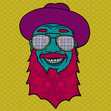Wilson Belshaw's Blog, page 6
May 17, 2020
Bahkauv
Bahkauv number among the strangest monsters in the Yelps Mountains. Some would say they rank among the weirdest beasts anywhere. They're essentially misshapen calves with ball and chain arms. When a person hears one of these monstrous heiffers mooing in the distance, they don't stop to ask, "how now, brown cow?" - they just run.
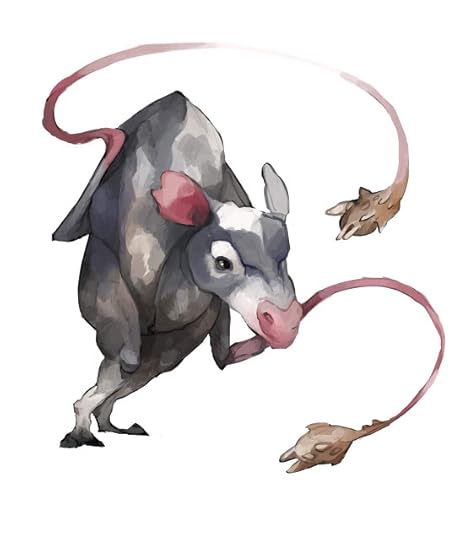 Bahkauv by Zuza Gruzlewska
Bahkauv by Zuza Gruzlewska
Being chased by a bahkauv tests the vigour of even the spryest adventurers. These beasts simply do not tire. And despite their obtuse body shape, they've got a real turn of speed on them. Having a wild-eyed bahkauv hoofing after you can be so motivating that Austrovian sports teams use them as training aides.
Bahkauv generally live out in the wild, but they will come into towns and villages in the winter months. When the temperatures drop and the mulled wine flows, potential victims will become less able to defend themselves. More than one person has stumbled out of a tavern only to see a bahkauv screaming towards them.
Although bahkauv will invade urban environments, they certainly aren't urban monsters. Adaptable beasts like manticores and shiboni have evolved to live alongside civilisation. Bahkauv just charge into it every so often to bludgeon the first person they see.
Bahkauv Facts
Bahkauv go: "MOOOOOOOOOO!"The bahkauv's natural 'ball and chain' arms are comprised of long muscles that end in exposed bone. They're basically like tongues with knee caps at the end.A group of bahkauv are collectively known as a 'mayhem'.During calving season, female bahkauv can squirt their milk offensively. Said milk is incredibly acidic and can actually burn through armour. Buy The Quest Factor here
Buy The Quest Factor here
Creation Notes
Bahkauv are a real-life mythical monster from Aachen, Germany. I learned about these beasts while reading up on the folklore of Germany and the Alps. According to legend, the bahkauv looked like deformed calves with sharp fangs. Weirdly, however, the statues dedicated to the beast din't really look like calves. See for yourself.
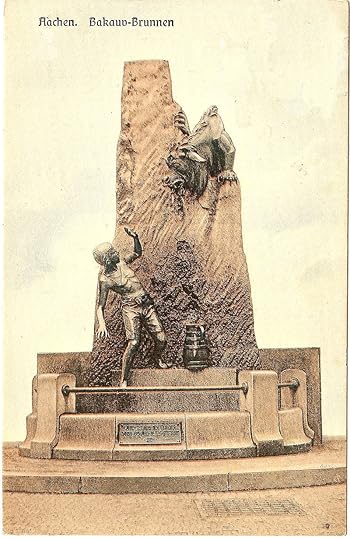
This one looks like some sort of half-ape goat-beast?
Unfortunately, the original statue was melted down for the metal in WW2. It was replaced by the one below.

This one looks more like a bald panther of some description?
So what's the deal? Do Germans not know what calves look like? Do calves look like goat-panthers in Germany? Has Wikipedia fed me a load of nonsense? Hard to say.
That Wikipedia article did have some more good info on bahkauv, though - namely that:
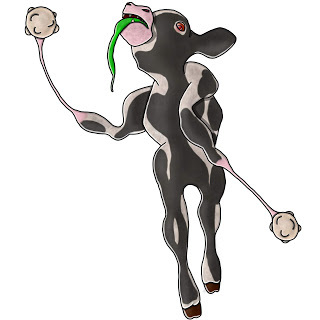 My original design for the bahkauv
My original design for the bahkauv
See Also
Alley ManticoresMonstersWild Monsters
Sign up to my mailing list below
Enter your email address
powered by TinyLetter
 Bahkauv by Zuza Gruzlewska
Bahkauv by Zuza GruzlewskaBeing chased by a bahkauv tests the vigour of even the spryest adventurers. These beasts simply do not tire. And despite their obtuse body shape, they've got a real turn of speed on them. Having a wild-eyed bahkauv hoofing after you can be so motivating that Austrovian sports teams use them as training aides.
Bahkauv generally live out in the wild, but they will come into towns and villages in the winter months. When the temperatures drop and the mulled wine flows, potential victims will become less able to defend themselves. More than one person has stumbled out of a tavern only to see a bahkauv screaming towards them.
Although bahkauv will invade urban environments, they certainly aren't urban monsters. Adaptable beasts like manticores and shiboni have evolved to live alongside civilisation. Bahkauv just charge into it every so often to bludgeon the first person they see.
Bahkauv Facts
Bahkauv go: "MOOOOOOOOOO!"The bahkauv's natural 'ball and chain' arms are comprised of long muscles that end in exposed bone. They're basically like tongues with knee caps at the end.A group of bahkauv are collectively known as a 'mayhem'.During calving season, female bahkauv can squirt their milk offensively. Said milk is incredibly acidic and can actually burn through armour.
 Buy The Quest Factor here
Buy The Quest Factor hereCreation Notes
Bahkauv are a real-life mythical monster from Aachen, Germany. I learned about these beasts while reading up on the folklore of Germany and the Alps. According to legend, the bahkauv looked like deformed calves with sharp fangs. Weirdly, however, the statues dedicated to the beast din't really look like calves. See for yourself.

This one looks like some sort of half-ape goat-beast?
Unfortunately, the original statue was melted down for the metal in WW2. It was replaced by the one below.

This one looks more like a bald panther of some description?
So what's the deal? Do Germans not know what calves look like? Do calves look like goat-panthers in Germany? Has Wikipedia fed me a load of nonsense? Hard to say.
That Wikipedia article did have some more good info on bahkauv, though - namely that:
The Bahkauv is associated with harassing drunk men. In legend, the creature would ambush intoxicated men at night and latch onto their shoulders, forcing them to carry it around before attacking themWhen I read this, I realised bahkauv were very in keeping with some of the other monsters I have, like the urban manticore. They actually ended up being a little bit too similar, which is why I made them more of a rampaging instrument of absurdity.
 My original design for the bahkauv
My original design for the bahkauvSee Also
Alley ManticoresMonstersWild Monsters
Sign up to my mailing list below
Enter your email address
powered by TinyLetter
Published on May 17, 2020 02:41
May 6, 2020
Magickal Monsters
The most dangerous monsters are the ones which have evolved to use magick. In the world of adventuring, this makes them the most fun to square off against. Unless you have no talent, obviously, in which case fighting them can be an absolute nightmare.
 Magick Monsters by Zuza Gruzlewska
Magick Monsters by Zuza Gruzlewska
Magickal monsters are infused with faer beings in some fashion. The two main types of magickal monster include:
Those which have some sort of inherent enchantment.Those which can cast spells.
The first group includes fiersome beasts like wind gibbons and abominable firemen. The latter ecompasses creatures like welves and aardzebras.
Enchanted monsters have tiny faer beings living inside them - much like how you or I have stomach bacteria. The aforementioned abominable firemen can withstand high temperatures as a result of tiny faer called ifrit. This makes it impossible for them to find a properly hot curry.
Other monsters use meech - the faer which cast spells on other creatures' behalf. Sentient beings cast magick in the same fashion, but unlike people, monsters tend to only know one spell. As warriors who've fought them will tell you, that's one spell too many.
Another big difference between magickal monsters and the regular kind is you can't summon them with a monster spawner. Instead, each one needs summoning by a trained summoner. This makes them less common in public dungeons. Partially because spawners cost less to run, but mainly because magickal monsters are better at escaping and causing law suits.
List of Magickal Monsters
Magickal monsters are much rarer than the regular kind. At the same time, there are infinite realms out there, and 'infinity' multiplied by 'rare' still adds up to a 'bucket load'. The following is a list of these beasties.
Aardzebras
These adorable yet terrifying creatures disable their prey with paralysis magick. What they do after that doesn't bear repeating. If you'd like to know more, however, I have extensively repeated it in the link below.
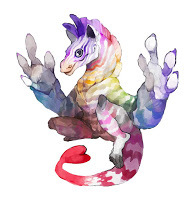
Read more about aardzebras here.
Hill Glaciants
These beasts are magickally imbued with faer that make them invulnerable to the cold. Combine that with the legs of a goat and the body of a tadpole and you get one of the most ferocious predators in the Yelps Mountains.
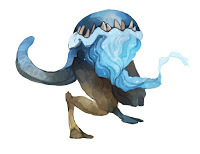
Read more about hill glaciants here.
Shiboni
These largely urban monsters use teleportation magick to quietly sneak up on their prey. They follow this up by using their clubs to loudly bludgeon them to death.
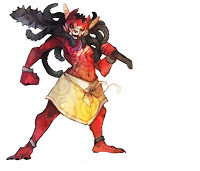
Welves
Welves are another type of monster that can paralyse their prey. This comes in useful, as they're essentially useless against non-paralysed victims. Their body shape is a good example of what monsterification can do to otherwise practical animals.
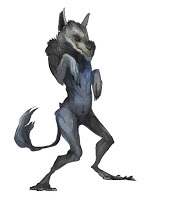
Read more about welves here.
See Also
Monsters
Sign up to my mailing list below
Enter your email address
powered by TinyLetter
 Magick Monsters by Zuza Gruzlewska
Magick Monsters by Zuza GruzlewskaMagickal monsters are infused with faer beings in some fashion. The two main types of magickal monster include:
Those which have some sort of inherent enchantment.Those which can cast spells.
The first group includes fiersome beasts like wind gibbons and abominable firemen. The latter ecompasses creatures like welves and aardzebras.
Enchanted monsters have tiny faer beings living inside them - much like how you or I have stomach bacteria. The aforementioned abominable firemen can withstand high temperatures as a result of tiny faer called ifrit. This makes it impossible for them to find a properly hot curry.
Other monsters use meech - the faer which cast spells on other creatures' behalf. Sentient beings cast magick in the same fashion, but unlike people, monsters tend to only know one spell. As warriors who've fought them will tell you, that's one spell too many.
Another big difference between magickal monsters and the regular kind is you can't summon them with a monster spawner. Instead, each one needs summoning by a trained summoner. This makes them less common in public dungeons. Partially because spawners cost less to run, but mainly because magickal monsters are better at escaping and causing law suits.
List of Magickal Monsters
Magickal monsters are much rarer than the regular kind. At the same time, there are infinite realms out there, and 'infinity' multiplied by 'rare' still adds up to a 'bucket load'. The following is a list of these beasties.
Aardzebras
These adorable yet terrifying creatures disable their prey with paralysis magick. What they do after that doesn't bear repeating. If you'd like to know more, however, I have extensively repeated it in the link below.

Read more about aardzebras here.
Hill Glaciants
These beasts are magickally imbued with faer that make them invulnerable to the cold. Combine that with the legs of a goat and the body of a tadpole and you get one of the most ferocious predators in the Yelps Mountains.

Read more about hill glaciants here.
Shiboni
These largely urban monsters use teleportation magick to quietly sneak up on their prey. They follow this up by using their clubs to loudly bludgeon them to death.

Welves
Welves are another type of monster that can paralyse their prey. This comes in useful, as they're essentially useless against non-paralysed victims. Their body shape is a good example of what monsterification can do to otherwise practical animals.

Read more about welves here.
See Also
Monsters
Sign up to my mailing list below
Enter your email address
powered by TinyLetter
Published on May 06, 2020 09:57
May 3, 2020
Aardzebras
People fear the diminutive aardzebras almost as much as they adore them. Numbering among the deadliest monsters in the 6in tall bracket, a pack can devour a person whole. Their victims remain conscious throughout, too. That people feel compelled to pet them despite this is testament to the aardzebras' cuteness.
 Aardzebra by Zuza Gruzlewska
Aardzebra by Zuza Gruzlewska
Aardzebras approach victims with their arms held out - encouraging them to drop their guard and go in for a hug. Once they've initiated contact, an aardzebra can paralyse their target with magick. With the victim debilitated, the pack will crawl inside their mouth and devour them from the inside out.
Surprisingly, some people keep aardzebras as pets. By using the right defensive magicks, a person can protect themselves from the monsters' paralysis spells. This requires a great deal of cautiousness on the owners' part, and more than one has let their guard slip over the years. This ends with a friend or loved one discovering a deflated corpse full of aardzebras.
Despite being borderline legal in some countries, keeping monsters as pets is obviously very much frowned upon. That's why it's generally left to weirdoes and criminals like the self-styled 'Dragon King' himself - Joey Erotic.
Aardzebra Facts
A pack of aardzebras are collectively known as an 'aww'.Aardzebras go: "OoOoOoOoOo."Aardzebras also purr and sing. Their multi-part harmonies can be even more captivating than their looks.Despite the name (and appearence), aardzebras have no relation to zebras. Zebra (equus quagga). Unrelated.
Zebra (equus quagga). Unrelated.
Creation Notes
The aardzebras are one of the creatures that only exist very briefly in the books. Background creatures often end up being the most interesting. Probably because:
They only appear for a second so why not make them really weird?Not having to focus on them too much means you don't have to ask questions like 'does this creature make sense?'
By creating this site I've shot myself in the foot, obviously, as I now have to give these things some sort of semi-plausible description.
See Also
MonstersMagickal Monsters
Sign up to my mailing list below
Enter your email address
powered by TinyLetter
 Aardzebra by Zuza Gruzlewska
Aardzebra by Zuza GruzlewskaAardzebras approach victims with their arms held out - encouraging them to drop their guard and go in for a hug. Once they've initiated contact, an aardzebra can paralyse their target with magick. With the victim debilitated, the pack will crawl inside their mouth and devour them from the inside out.
Surprisingly, some people keep aardzebras as pets. By using the right defensive magicks, a person can protect themselves from the monsters' paralysis spells. This requires a great deal of cautiousness on the owners' part, and more than one has let their guard slip over the years. This ends with a friend or loved one discovering a deflated corpse full of aardzebras.
Despite being borderline legal in some countries, keeping monsters as pets is obviously very much frowned upon. That's why it's generally left to weirdoes and criminals like the self-styled 'Dragon King' himself - Joey Erotic.
Aardzebra Facts
A pack of aardzebras are collectively known as an 'aww'.Aardzebras go: "OoOoOoOoOo."Aardzebras also purr and sing. Their multi-part harmonies can be even more captivating than their looks.Despite the name (and appearence), aardzebras have no relation to zebras.
 Zebra (equus quagga). Unrelated.
Zebra (equus quagga). Unrelated.Creation Notes
The aardzebras are one of the creatures that only exist very briefly in the books. Background creatures often end up being the most interesting. Probably because:
They only appear for a second so why not make them really weird?Not having to focus on them too much means you don't have to ask questions like 'does this creature make sense?'
By creating this site I've shot myself in the foot, obviously, as I now have to give these things some sort of semi-plausible description.
See Also
MonstersMagickal Monsters
Sign up to my mailing list below
Enter your email address
powered by TinyLetter
Published on May 03, 2020 04:42
April 13, 2020
Gob-Nommoth
The outerfiend known as Gob-Nommoth lives aboard the Iron Blimp - an airship owned by Smarman the sorcerer. While most of its ilk sustain themselves by eating - well - everyone, this fiend has a very different lifestyle. By feeding it a constant diet of crudemana, Smarman has turned the thing into an engine.
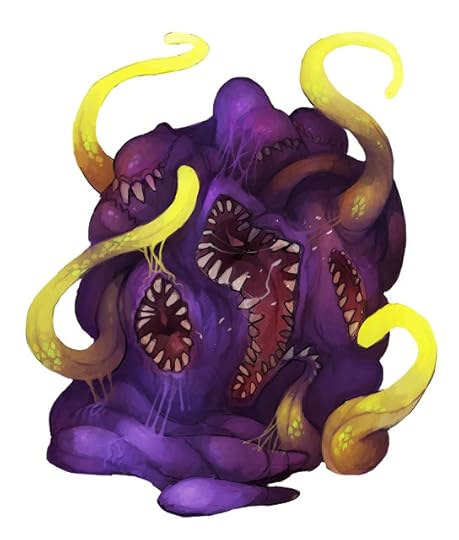 Gob-Nommoth by Zuza Gruzlewska
Gob-Nommoth by Zuza Gruzlewska
The outerfiend Gob-Nommoth looks like a house-sized drain clog with an outbreak of mouths. Living inside the engine room of the Iron Blimp, it uses its tentacles to grab dolls and devour them. These 'dolls' are actually a substance known as 'foss' wrapped in children's clothes.
Companies acquire foss by sending adventurers to The Dread Zone! to fight skeleterrors - the bones of which can be processed into crudemana – the fuel which gives rise to the phenomenon known as ‘galactic dreadening’. Some question if feeding Gob-Nommoth these child-like dolls only encourages its genocidal appetites. Others point out that it's better for it to be indoors eating dolls than outside eating everyone.
Another question people ask is "Why? Why have this murderous abomination on your airship?" The answer is that as a result of eating all that crudemana, magick regularly explodes from Gob-Nommoth's head (or from 'its top', anyway. Obviously it doesn't really have a head, although it does have a 'void hole' - an unholy cross between a nostril and an anus).
The expelled magick becomes captured inside the balloon part of the Iron Blimp - a ballon quite literally made from iron. As the metal reflects magick, the enchantments inside it become trapped and create the lift that keeps the improbable airship afloat.
Smarman originally tried making his zeppelin out of lead, but the craft plummeted to the ground and exploded. This proved especially problematic when the outerfiend on board escaped. It ate several men before being recaptured - all of them named Daniel, weirdly - making it something of a danpage.
 Oh, the fiendishness!
Oh, the fiendishness!
Creation Notes
I didn't have any advanced plans for Gob-Nommoth when I was writing The Quest Factor - there's just a part in the book when the characters take a tour around the Iron Blimp and I thought:
After some thought, the only logical conclusion was that Smarman used some sort of galactic space horror to fart rainbow-magick into the metal balloon. My original design for it looked like this:
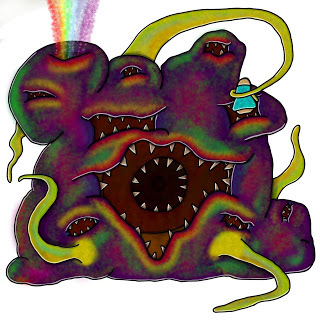 Gob-Nommoth by Wilson Belshaw
Gob-Nommoth by Wilson Belshaw
If you think the name 'Gob-Nommoth' sounds familiar, there's a good reason for that, as it's a reference to 'Yob Soddoth' from the Discworld series (which is itself a reference to 'Yog-Sothoth' from the H.P. Lovecraft's Cthulu mythos). The descriptive comedy name mirrors the Discworld series, while making it an 'outerfiend' references that Yog-Sothoth belonged to Lovecraft's 'Outer Gods'.
For Gob-Nommoth's appearance I went with 'generic tentacle blob'.Yog-Sothoth itself was described as looking like a conglomeration of "malignant globes". I'll probably make something else look like a conglomeration of "malignant globes", as that could either be the most terrifying or ridiculous thing imaginable.
Yog-Sothoth was actually the grandfather of Cthulu itself. The Outer God sometimes went by the name 'The Lurker at the Threshold', which makes me think of some greasebag who's got himself barred from the off license and wants you to go in for him.
 Yog-Sothoth, or 'Pappa Yoggy' as Cthulu called him
Yog-Sothoth, or 'Pappa Yoggy' as Cthulu called him
See Also
FiendsOuterfiends
Sign up to my mailing list below
Enter your email address
powered by TinyLetter
 Gob-Nommoth by Zuza Gruzlewska
Gob-Nommoth by Zuza GruzlewskaThe outerfiend Gob-Nommoth looks like a house-sized drain clog with an outbreak of mouths. Living inside the engine room of the Iron Blimp, it uses its tentacles to grab dolls and devour them. These 'dolls' are actually a substance known as 'foss' wrapped in children's clothes.
Companies acquire foss by sending adventurers to The Dread Zone! to fight skeleterrors - the bones of which can be processed into crudemana – the fuel which gives rise to the phenomenon known as ‘galactic dreadening’. Some question if feeding Gob-Nommoth these child-like dolls only encourages its genocidal appetites. Others point out that it's better for it to be indoors eating dolls than outside eating everyone.
Another question people ask is "Why? Why have this murderous abomination on your airship?" The answer is that as a result of eating all that crudemana, magick regularly explodes from Gob-Nommoth's head (or from 'its top', anyway. Obviously it doesn't really have a head, although it does have a 'void hole' - an unholy cross between a nostril and an anus).
The expelled magick becomes captured inside the balloon part of the Iron Blimp - a ballon quite literally made from iron. As the metal reflects magick, the enchantments inside it become trapped and create the lift that keeps the improbable airship afloat.
Smarman originally tried making his zeppelin out of lead, but the craft plummeted to the ground and exploded. This proved especially problematic when the outerfiend on board escaped. It ate several men before being recaptured - all of them named Daniel, weirdly - making it something of a danpage.
 Oh, the fiendishness!
Oh, the fiendishness!Creation Notes
I didn't have any advanced plans for Gob-Nommoth when I was writing The Quest Factor - there's just a part in the book when the characters take a tour around the Iron Blimp and I thought:
"Oh flepp - so how does this thing stay airborne?"
After some thought, the only logical conclusion was that Smarman used some sort of galactic space horror to fart rainbow-magick into the metal balloon. My original design for it looked like this:
 Gob-Nommoth by Wilson Belshaw
Gob-Nommoth by Wilson BelshawIf you think the name 'Gob-Nommoth' sounds familiar, there's a good reason for that, as it's a reference to 'Yob Soddoth' from the Discworld series (which is itself a reference to 'Yog-Sothoth' from the H.P. Lovecraft's Cthulu mythos). The descriptive comedy name mirrors the Discworld series, while making it an 'outerfiend' references that Yog-Sothoth belonged to Lovecraft's 'Outer Gods'.
For Gob-Nommoth's appearance I went with 'generic tentacle blob'.Yog-Sothoth itself was described as looking like a conglomeration of "malignant globes". I'll probably make something else look like a conglomeration of "malignant globes", as that could either be the most terrifying or ridiculous thing imaginable.
Yog-Sothoth was actually the grandfather of Cthulu itself. The Outer God sometimes went by the name 'The Lurker at the Threshold', which makes me think of some greasebag who's got himself barred from the off license and wants you to go in for him.
 Yog-Sothoth, or 'Pappa Yoggy' as Cthulu called him
Yog-Sothoth, or 'Pappa Yoggy' as Cthulu called himSee Also
FiendsOuterfiends
Sign up to my mailing list below
Enter your email address
powered by TinyLetter
Published on April 13, 2020 09:06
April 3, 2020
Hill Glaciants
Hill glaciants combine the sure-footedness of a goat with the ferocity of a tiger (and the body-shape of a tadpole). Anyone visiting the Yelp Mountains will see these beasties on distant rock faces - traversing the most minimal of footholds on the most vertical of cliffs. They may also see one flanking them from behind. They won't see this for long, however, as the glaciants will promptly kick them to death.
 Hill Glaciant by Zuza Gruzlewska
Hill Glaciant by Zuza Gruzlewska
On Tumultia, most nations have eradicated monsters. You still get them in places like the Yelps, as hunting them appeals to tourists. It also gives the locals something to do/kill.
Despite having the freedom to hunt hill glaciants, most adventurers avoid them. They're huge, for a start, with each one standing about 15ft tall. They're also famously ferocious - a trait they combine with the ability to kick a person's head clean off their shoulders (and the jaw strength to bite through stone).
On top of all this, it's difficult to fight them on an even footing on their home turf. The nimble hill glaciants can run up vertical walls and sprint across ice. This makes fighting them more difficult than giving a tiger an unwanted bath.
Partly the hill glaciants' mastery of their environment comes from their ability to use frost magick. Their big, icy beards form as a result of this skill. Said beards usually have a flow to them, but glaciants can harden them into pure ice when needed. This allows them to use their beards as head-stands when sleeping.
Hill Glaciant Facts
Hill glaciants are related to the much larger (and now extinct) 'mountain glaciants'.Although silent more often than not, when hill glaciants do make a noise they go: "BAAAAA!"A group of hill glaciants are collectively known as a 'kicking'.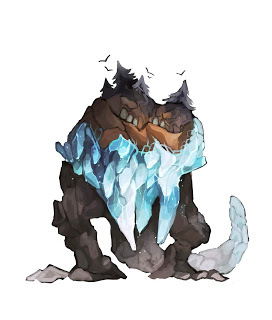 Mountain glaciant by Zuza Gruzlewska
Mountain glaciant by Zuza Gruzlewska
Creation Notes
The glaciants will feature in my upcoming book The Fame Eaters. I didn't really know what they'd look like when I started drawing them. Somehow I ended up with the image below - a blue meatball with a beard, tail, and goat legs.
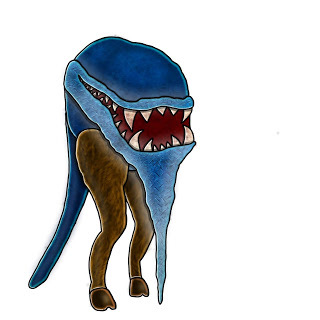 Hill Glaciant by Wilson Belshaw
Hill Glaciant by Wilson Belshaw
Possibly I meant to come back and redesign them at some point?
Either way, I quite like them! I've always felt terrified by the thought of mountain goats climbing up sheers rock faces - presumably because the thought of falling off a mountain is horrible. Hill glaciants combine that terrifying, goaty goodness with some genuine menace.
 Just live somewhere flat for god's sake!
Just live somewhere flat for god's sake!
See Also
MonstersMagickal Monsters
Sign up to my mailing list below
Enter your email address
powered by TinyLetter
 Hill Glaciant by Zuza Gruzlewska
Hill Glaciant by Zuza GruzlewskaOn Tumultia, most nations have eradicated monsters. You still get them in places like the Yelps, as hunting them appeals to tourists. It also gives the locals something to do/kill.
Despite having the freedom to hunt hill glaciants, most adventurers avoid them. They're huge, for a start, with each one standing about 15ft tall. They're also famously ferocious - a trait they combine with the ability to kick a person's head clean off their shoulders (and the jaw strength to bite through stone).
On top of all this, it's difficult to fight them on an even footing on their home turf. The nimble hill glaciants can run up vertical walls and sprint across ice. This makes fighting them more difficult than giving a tiger an unwanted bath.
Partly the hill glaciants' mastery of their environment comes from their ability to use frost magick. Their big, icy beards form as a result of this skill. Said beards usually have a flow to them, but glaciants can harden them into pure ice when needed. This allows them to use their beards as head-stands when sleeping.
Hill Glaciant Facts
Hill glaciants are related to the much larger (and now extinct) 'mountain glaciants'.Although silent more often than not, when hill glaciants do make a noise they go: "BAAAAA!"A group of hill glaciants are collectively known as a 'kicking'.
 Mountain glaciant by Zuza Gruzlewska
Mountain glaciant by Zuza GruzlewskaCreation Notes
The glaciants will feature in my upcoming book The Fame Eaters. I didn't really know what they'd look like when I started drawing them. Somehow I ended up with the image below - a blue meatball with a beard, tail, and goat legs.
 Hill Glaciant by Wilson Belshaw
Hill Glaciant by Wilson BelshawPossibly I meant to come back and redesign them at some point?
Either way, I quite like them! I've always felt terrified by the thought of mountain goats climbing up sheers rock faces - presumably because the thought of falling off a mountain is horrible. Hill glaciants combine that terrifying, goaty goodness with some genuine menace.
 Just live somewhere flat for god's sake!
Just live somewhere flat for god's sake!See Also
MonstersMagickal Monsters
Sign up to my mailing list below
Enter your email address
powered by TinyLetter
Published on April 03, 2020 05:21
March 29, 2020
Outerfiends
Outerfiends number among the most destructive of all entities in the multiverse. Thankfully, these horrors are few and far between. So 'far' in fact that the distance between them is measured in light years.
These cosmic terrors float through the deep, dark depths of space on the look out for inhabited planets. After hibernating for several aeons, outerfiends wake up with an insatiable appetite. Unfortunately for the lifeforms they meet, they combine this insatiable appetite with a bottomless stomach.
 Historical depiction of a space krakenLike all of their fiendish cousins, outerfiends devour mortals for mana - a magickal substance that physical beings naturally accumulate. While it's possible to take mana without eating people, doing so takes longer, and fiends have places to go and people to eat. Outerfiends have a lot of people to eat, too. After landing on a planet, they'll set about devouring every man, woman, and kangaroo on it.
Historical depiction of a space krakenLike all of their fiendish cousins, outerfiends devour mortals for mana - a magickal substance that physical beings naturally accumulate. While it's possible to take mana without eating people, doing so takes longer, and fiends have places to go and people to eat. Outerfiends have a lot of people to eat, too. After landing on a planet, they'll set about devouring every man, woman, and kangaroo on it.
Outerfiends grow larger as they eat more and more of the native lifeforms. They might not be too big to start with, as outerfiends shrink down to their core size during their long hibernations. By the time they land on a planet, they may be no larger than a show pony. By the time they leave, you can usually see them from space.
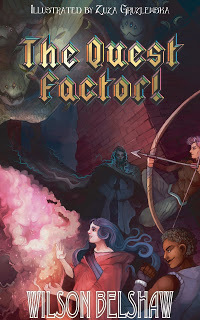 You can purchase The Quest Factor by clicking here
You can purchase The Quest Factor by clicking here
List of Outerfiends
Sorcologists tend to know outerfiends individually rather than as separate groups. It could be that different varieties will be categorised, but for now not that much is known about them - only that every one seems similar but different to its contemporaries - all looking like galactic drain clogs of some description.
0H-5H1T
Given the risk that outerfiends pose to life on Tumultia, ever-vigilant astronomers keep an eye out for them. The cosmic horror designated 0H-5H1T numbers among the outerfiends they've thus far observed. According to many projections, oH-5H1T's current course will see it colliding with Tumultia and devouring all life on the planet. According to others, sentient kind will likely have wiped itself out waaay before that can happen.
 Recent picture showing 0H-5H1T's position. Can you see it? It's somewhere in the middle. Can you see it? It's there, I promise you. Are you looking good? Well I don't know - maybe get your eyes tested or something?
Recent picture showing 0H-5H1T's position. Can you see it? It's somewhere in the middle. Can you see it? It's there, I promise you. Are you looking good? Well I don't know - maybe get your eyes tested or something?
Chicxulub
Geomancers have shown through rigorous geomancing that an outerfiend collided with Tumultia some several billion years ago. They refer to this entity as Chicxulub. Its time on the planet coincides with the extinction of the dinopoodles - a group of dog-like mega-floofs that ruled the planet before sentient kind existed.
Gob-Nommoth
Gob-Nommoth is the name of the outerfiend that Smarman the sorcerer uses to power his airship, the Iron Blimp. By providing it with steady yet minimal sustenance, the sorcerer can prevent the fiend growing while also taking advantage of the magick that spurts out from its void hole. This isn't what you'd call a safety conscious approach to air travel. As an immortal terror with unfathomable influence, Smarman can get away with it.
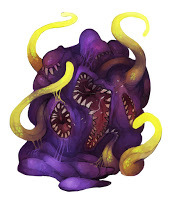 Gob-Nommoth by Zuza Gruzlewska
Gob-Nommoth by Zuza Gruzlewska
You can read more about Gob-Nommoth here.
See Also
FiendsGob-NommothThe Quest Factor
Sign up to my mailing list below
Enter your email address
powered by TinyLetter
These cosmic terrors float through the deep, dark depths of space on the look out for inhabited planets. After hibernating for several aeons, outerfiends wake up with an insatiable appetite. Unfortunately for the lifeforms they meet, they combine this insatiable appetite with a bottomless stomach.
 Historical depiction of a space krakenLike all of their fiendish cousins, outerfiends devour mortals for mana - a magickal substance that physical beings naturally accumulate. While it's possible to take mana without eating people, doing so takes longer, and fiends have places to go and people to eat. Outerfiends have a lot of people to eat, too. After landing on a planet, they'll set about devouring every man, woman, and kangaroo on it.
Historical depiction of a space krakenLike all of their fiendish cousins, outerfiends devour mortals for mana - a magickal substance that physical beings naturally accumulate. While it's possible to take mana without eating people, doing so takes longer, and fiends have places to go and people to eat. Outerfiends have a lot of people to eat, too. After landing on a planet, they'll set about devouring every man, woman, and kangaroo on it.Outerfiends grow larger as they eat more and more of the native lifeforms. They might not be too big to start with, as outerfiends shrink down to their core size during their long hibernations. By the time they land on a planet, they may be no larger than a show pony. By the time they leave, you can usually see them from space.
 You can purchase The Quest Factor by clicking here
You can purchase The Quest Factor by clicking hereList of Outerfiends
Sorcologists tend to know outerfiends individually rather than as separate groups. It could be that different varieties will be categorised, but for now not that much is known about them - only that every one seems similar but different to its contemporaries - all looking like galactic drain clogs of some description.
0H-5H1T
Given the risk that outerfiends pose to life on Tumultia, ever-vigilant astronomers keep an eye out for them. The cosmic horror designated 0H-5H1T numbers among the outerfiends they've thus far observed. According to many projections, oH-5H1T's current course will see it colliding with Tumultia and devouring all life on the planet. According to others, sentient kind will likely have wiped itself out waaay before that can happen.
 Recent picture showing 0H-5H1T's position. Can you see it? It's somewhere in the middle. Can you see it? It's there, I promise you. Are you looking good? Well I don't know - maybe get your eyes tested or something?
Recent picture showing 0H-5H1T's position. Can you see it? It's somewhere in the middle. Can you see it? It's there, I promise you. Are you looking good? Well I don't know - maybe get your eyes tested or something?Chicxulub
Geomancers have shown through rigorous geomancing that an outerfiend collided with Tumultia some several billion years ago. They refer to this entity as Chicxulub. Its time on the planet coincides with the extinction of the dinopoodles - a group of dog-like mega-floofs that ruled the planet before sentient kind existed.
Gob-Nommoth
Gob-Nommoth is the name of the outerfiend that Smarman the sorcerer uses to power his airship, the Iron Blimp. By providing it with steady yet minimal sustenance, the sorcerer can prevent the fiend growing while also taking advantage of the magick that spurts out from its void hole. This isn't what you'd call a safety conscious approach to air travel. As an immortal terror with unfathomable influence, Smarman can get away with it.
 Gob-Nommoth by Zuza Gruzlewska
Gob-Nommoth by Zuza GruzlewskaYou can read more about Gob-Nommoth here.
See Also
FiendsGob-NommothThe Quest Factor
Sign up to my mailing list below
Enter your email address
powered by TinyLetter
Published on March 29, 2020 05:50
March 20, 2020
Wolperdingers
While necromancers are far from the liveliest bunch, they do enjoy a little diversion from time to time. Their dark frolics often involve the creation of a wolperdinger - a reanimated construct created from spare animal parts. The enjoyment non-necromancers receive from these weird Frankenducks will depend on how amusing they find soulless abominations.
 A Duzulspimk Wolperdinger by Zuza Gruzlewska
A Duzulspimk Wolperdinger by Zuza Gruzlewska
Like all undead, wolperdingers follow commands from the necromancer who animated them. Their ability to carry out said instructions will largely depend on the construct's practicality. You can make these things out of anything, but while no one will stop you creating a goat with the legs of a duck and the head of a squirrel, that doesn't mean the end product will have any practical application.
Given the work that goes into creating a wolperdinger, most tend to be taxidermied. This means they smell better than most undead. It's this extra effort that puts most practitioners off as necromancers tend towards the unhygienic. For some reason they view beating death as less of a challenge than beating body odour.

The Duzulspimk Wolperdingers
An Austrovian town named Duzulspimk suffers from an interesting wolperdinger infestation. The person who created the source of this problem used parts from a pine marten, a duck, a jay, and a ram. They created it for a competition. Said competition involved amateur necromancers hiding wolperdingers around town as part of a treasure hunt. Problems arose when one got hidden in the worst possible location.
Duzulspimk lies in the Yelps in the shadow of Mount Mordberg. Its peaks rise so high that they enter the majosphere - the area where magickal particles accumulate. Unfortunately for everyone in town, one necromancer hid his wolperdinger in this troublesome band of atmosphere. Hocus pocus ensued as a result.
The original wolperdinger took on a life of its own after being exposed to the enchanted majosphere. Once this happened, it began creating more wolperdingers - acquiring the requisite body parts through less than savoury methods. Fortunately for Duzulspimk, the soulless duck weasels lacked the claws and sharp teeth needed to murder people. This wasn't for a lack of trying, however. They try it so often that Duzulspimk residents need eyes in the back of their heads - a feat they achieve with enchanted glasses.
 You can purchase The Quest Factor by clicking here
Wolperdinger Facts
You can purchase The Quest Factor by clicking here
Wolperdinger Facts
The collective noun for ordinary wolperdingers is the same as all reanimated corpses - a 'shamble'. The enchanted wolperdingers of Duzulspimk go by a 'ruckus'.Wolperdingers can make a variety of noises - it all depends on what sort of mouth they have.The wolperdingers in Duzulspimk go: "QWUAWHK!" or "hiss!"
Creation Notes
Wolperdingers will feature in the upcoming novel The Fame Eaters. I read about them when researching mythology of the alps. Using them in the book me to thinking about how a reanimated creature would work in the Tumultiverse. I decided that a person would take a corpse of some description and pump it full of dread particles - basically like creating a donut only with horror instead of jam.
If you'd like to see some real-life wolperdingers (or 'wolpertingers'), then look no further:
 This one's on the bunny
This one's on the bunny
 Un-bearable
Un-bearable
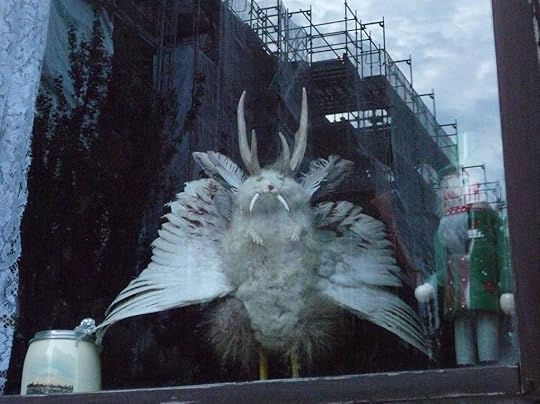 This might be the weirdest
This might be the weirdest
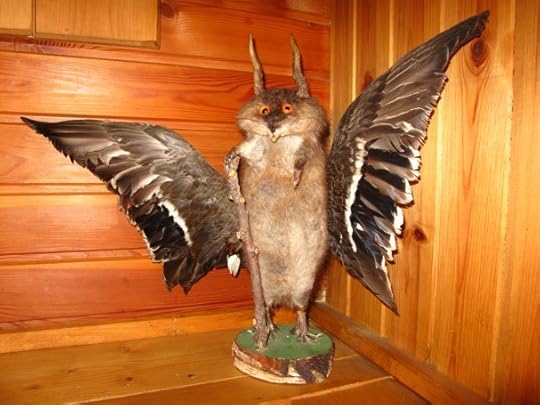 No, wait - this is the weirdest
No, wait - this is the weirdest
 No, wait...
No, wait...
 ...wait...
...wait...
 ...???
...???
 And finally, the one that inspired the Duzulspimk wolperdinger
See Also
And finally, the one that inspired the Duzulspimk wolperdinger
See Also
BestiaryMonstersThe Undead
Sign up to my mailing list belowEnter your email address
powered by TinyLetter
 A Duzulspimk Wolperdinger by Zuza Gruzlewska
A Duzulspimk Wolperdinger by Zuza GruzlewskaLike all undead, wolperdingers follow commands from the necromancer who animated them. Their ability to carry out said instructions will largely depend on the construct's practicality. You can make these things out of anything, but while no one will stop you creating a goat with the legs of a duck and the head of a squirrel, that doesn't mean the end product will have any practical application.
Given the work that goes into creating a wolperdinger, most tend to be taxidermied. This means they smell better than most undead. It's this extra effort that puts most practitioners off as necromancers tend towards the unhygienic. For some reason they view beating death as less of a challenge than beating body odour.

The Duzulspimk Wolperdingers
An Austrovian town named Duzulspimk suffers from an interesting wolperdinger infestation. The person who created the source of this problem used parts from a pine marten, a duck, a jay, and a ram. They created it for a competition. Said competition involved amateur necromancers hiding wolperdingers around town as part of a treasure hunt. Problems arose when one got hidden in the worst possible location.
Duzulspimk lies in the Yelps in the shadow of Mount Mordberg. Its peaks rise so high that they enter the majosphere - the area where magickal particles accumulate. Unfortunately for everyone in town, one necromancer hid his wolperdinger in this troublesome band of atmosphere. Hocus pocus ensued as a result.
The original wolperdinger took on a life of its own after being exposed to the enchanted majosphere. Once this happened, it began creating more wolperdingers - acquiring the requisite body parts through less than savoury methods. Fortunately for Duzulspimk, the soulless duck weasels lacked the claws and sharp teeth needed to murder people. This wasn't for a lack of trying, however. They try it so often that Duzulspimk residents need eyes in the back of their heads - a feat they achieve with enchanted glasses.
 You can purchase The Quest Factor by clicking here
Wolperdinger Facts
You can purchase The Quest Factor by clicking here
Wolperdinger Facts
The collective noun for ordinary wolperdingers is the same as all reanimated corpses - a 'shamble'. The enchanted wolperdingers of Duzulspimk go by a 'ruckus'.Wolperdingers can make a variety of noises - it all depends on what sort of mouth they have.The wolperdingers in Duzulspimk go: "QWUAWHK!" or "hiss!"
Creation Notes
Wolperdingers will feature in the upcoming novel The Fame Eaters. I read about them when researching mythology of the alps. Using them in the book me to thinking about how a reanimated creature would work in the Tumultiverse. I decided that a person would take a corpse of some description and pump it full of dread particles - basically like creating a donut only with horror instead of jam.
If you'd like to see some real-life wolperdingers (or 'wolpertingers'), then look no further:
 This one's on the bunny
This one's on the bunny
 Un-bearable
Un-bearable
 This might be the weirdest
This might be the weirdest
 No, wait - this is the weirdest
No, wait - this is the weirdest
 No, wait...
No, wait...
 ...wait...
...wait...
 ...???
...???
 And finally, the one that inspired the Duzulspimk wolperdinger
See Also
And finally, the one that inspired the Duzulspimk wolperdinger
See Also
BestiaryMonstersThe Undead
Sign up to my mailing list belowEnter your email address
powered by TinyLetter
Published on March 20, 2020 11:03
March 19, 2020
The Undead
Necromancers create undead by taking formerly living beings and infusing them with dread particles. They follow the same process to make golems - using dead bodies is just a grosser way of doing it. For most, the unpleasantness of handling a corpse puts them right off. For others, it does quite the opposite.
 Reanimated skeletons putting on an evil jigUndead can be created in two key ways. The first is creepy, but the second is chilling. Chilling and creepy.
Reanimated skeletons putting on an evil jigUndead can be created in two key ways. The first is creepy, but the second is chilling. Chilling and creepy.
The primary method of creating undead will be covered here. You can consider these entities the 'classic undead' and their counterparts the 'viral dead'. They differ in that undead are essentially just golems by grizzly means, whereas the viral dead may retain some degree of personality.
Necromancers can legally resurrect animals but not sentient beings. Lawmakers had the good sense to ban this dark practice some time ago, although drunk teens do still carry out the odd reanimation. Often this will end with them taking a corpse for a piggyback joyride or sending a skeleton through a teacher's catflap for a laugh.
Healers have an exception to the no-people rule, as having medical cadavers that can put their own guts back in saves a lot of time and money.
If you're wondering what happens when you reanimate a monster, the answer is you get a doubly bad monster - a hideous creature with the malevolence of a fiend and the stamina of a zombie. Teenagers will often try this at some point - the vast majority of necromancy being carried out by bored young people. They mainly do it behind the penny farthing sheds on their lunch breaks. Little weirdos.
 You can purchase The Quest Factor by clicking here
You can purchase The Quest Factor by clicking here
List of the Undead
This isn't a list of every living entity that can be brought back in undeath, because that would be a list of every animal, plant, and mushroom in existence. Instead, this will cover the broad types of undead that a necromancer can create.
Blood Golems
The simple way of creating an undead is to get a corpse and do some magick on it. Those who enjoy a little challenge with their depravity create entities known as 'blood golems'.
Creating a blood golem requires a great deal of blood - more than you'd find in most individual entities. A necromancer will put this blood in a cauldron and subject it to a series of spells and enchantments. Once done, the gore will become shapable. This results in a golem that can change form on command.
Although listed as 'blood' golems here, they can be created with any tissue - blood just requires the least liquidising. Similar creations include flesh golems, spleen golems, and $%£@ golems.
Floralich
As plants and funguses live and die, that means they can also be brought back in undeath. Being fairly immobile entities, you often can't tell. People do it mostly to create spoopy Gallow's Eve pumpkins that can pull faces and utter curses.
 Undead dandelion. Spooky, right?
Undead dandelion. Spooky, right?
Reanimates
A reanimate is a corpse that some seedy necromancer has brought back to life. Whether people or animals, reanimates are notable for having a decent amount of flesh left. A talented necromancer will treat this flesh to prevent it smelling. The untalented ones - i.e. most of them - simply make do with the stink.
 Teenage necromancers on horseback looking to cause trouble
Teenage necromancers on horseback looking to cause trouble
Skeletons
It requires far more skill to reanimate a skeleton because they have nothing connecting all the bits. In the old days they'd put puppet shows on using animated skeletons. In the modern era, they use synthetic ones. Or they would if people still put puppet shows on, anyway.
 A reanimated skeleton escorting a threesome of teenage necrmancers
A reanimated skeleton escorting a threesome of teenage necrmancers
Wolperdingers
So-called 'wolperdingers' have different names depending on the region - names like 'jackalope' or 'rasselbock'. People create them by taking a bunch of dead animal parts, stitching them altogether, and animating the results.
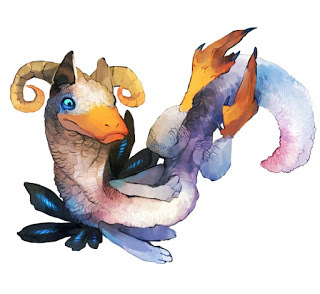 Wolperdinger by Zuza GruzlewskaZoats
Wolperdinger by Zuza GruzlewskaZoats
An oddity among all the animals you can bring back as undead are goats (or 'zoats' as people refer to the reanimated versions). For some reason, when you infuse a goat corpse with dread particles, it comes back pretty much normal. The only difference is they have glowing, blue eyes and the milk they produce is black, unholy, and cursed.
Necromancers use zoat milk to produce a variety of heinous cheeses like the dreaded zorgonzola or the blasphemous uncheddar. While no one normal would eat these depraved dairy products, people who play around with dead animals already have some experience ignoring social norms.
According to necromancers, eating it helps them focus their dark energies. According to the sorcologists who've studied these sinful cheeses, any 'dark energies' coming out of them are more than likely the result of a noxious bile reflex.
See Also
Bestiary Monsters
Sign up to my mailing list below
Enter your email address
powered by TinyLetter
 Reanimated skeletons putting on an evil jigUndead can be created in two key ways. The first is creepy, but the second is chilling. Chilling and creepy.
Reanimated skeletons putting on an evil jigUndead can be created in two key ways. The first is creepy, but the second is chilling. Chilling and creepy.The primary method of creating undead will be covered here. You can consider these entities the 'classic undead' and their counterparts the 'viral dead'. They differ in that undead are essentially just golems by grizzly means, whereas the viral dead may retain some degree of personality.
Necromancers can legally resurrect animals but not sentient beings. Lawmakers had the good sense to ban this dark practice some time ago, although drunk teens do still carry out the odd reanimation. Often this will end with them taking a corpse for a piggyback joyride or sending a skeleton through a teacher's catflap for a laugh.
Healers have an exception to the no-people rule, as having medical cadavers that can put their own guts back in saves a lot of time and money.
If you're wondering what happens when you reanimate a monster, the answer is you get a doubly bad monster - a hideous creature with the malevolence of a fiend and the stamina of a zombie. Teenagers will often try this at some point - the vast majority of necromancy being carried out by bored young people. They mainly do it behind the penny farthing sheds on their lunch breaks. Little weirdos.
 You can purchase The Quest Factor by clicking here
You can purchase The Quest Factor by clicking hereList of the Undead
This isn't a list of every living entity that can be brought back in undeath, because that would be a list of every animal, plant, and mushroom in existence. Instead, this will cover the broad types of undead that a necromancer can create.
Blood Golems
The simple way of creating an undead is to get a corpse and do some magick on it. Those who enjoy a little challenge with their depravity create entities known as 'blood golems'.
Creating a blood golem requires a great deal of blood - more than you'd find in most individual entities. A necromancer will put this blood in a cauldron and subject it to a series of spells and enchantments. Once done, the gore will become shapable. This results in a golem that can change form on command.
Although listed as 'blood' golems here, they can be created with any tissue - blood just requires the least liquidising. Similar creations include flesh golems, spleen golems, and $%£@ golems.
Floralich
As plants and funguses live and die, that means they can also be brought back in undeath. Being fairly immobile entities, you often can't tell. People do it mostly to create spoopy Gallow's Eve pumpkins that can pull faces and utter curses.
 Undead dandelion. Spooky, right?
Undead dandelion. Spooky, right?Reanimates
A reanimate is a corpse that some seedy necromancer has brought back to life. Whether people or animals, reanimates are notable for having a decent amount of flesh left. A talented necromancer will treat this flesh to prevent it smelling. The untalented ones - i.e. most of them - simply make do with the stink.
 Teenage necromancers on horseback looking to cause trouble
Teenage necromancers on horseback looking to cause troubleSkeletons
It requires far more skill to reanimate a skeleton because they have nothing connecting all the bits. In the old days they'd put puppet shows on using animated skeletons. In the modern era, they use synthetic ones. Or they would if people still put puppet shows on, anyway.
 A reanimated skeleton escorting a threesome of teenage necrmancers
A reanimated skeleton escorting a threesome of teenage necrmancersWolperdingers
So-called 'wolperdingers' have different names depending on the region - names like 'jackalope' or 'rasselbock'. People create them by taking a bunch of dead animal parts, stitching them altogether, and animating the results.
 Wolperdinger by Zuza GruzlewskaZoats
Wolperdinger by Zuza GruzlewskaZoatsAn oddity among all the animals you can bring back as undead are goats (or 'zoats' as people refer to the reanimated versions). For some reason, when you infuse a goat corpse with dread particles, it comes back pretty much normal. The only difference is they have glowing, blue eyes and the milk they produce is black, unholy, and cursed.
Necromancers use zoat milk to produce a variety of heinous cheeses like the dreaded zorgonzola or the blasphemous uncheddar. While no one normal would eat these depraved dairy products, people who play around with dead animals already have some experience ignoring social norms.
According to necromancers, eating it helps them focus their dark energies. According to the sorcologists who've studied these sinful cheeses, any 'dark energies' coming out of them are more than likely the result of a noxious bile reflex.
See Also
Bestiary Monsters
Sign up to my mailing list below
Enter your email address
powered by TinyLetter
Published on March 19, 2020 05:29

